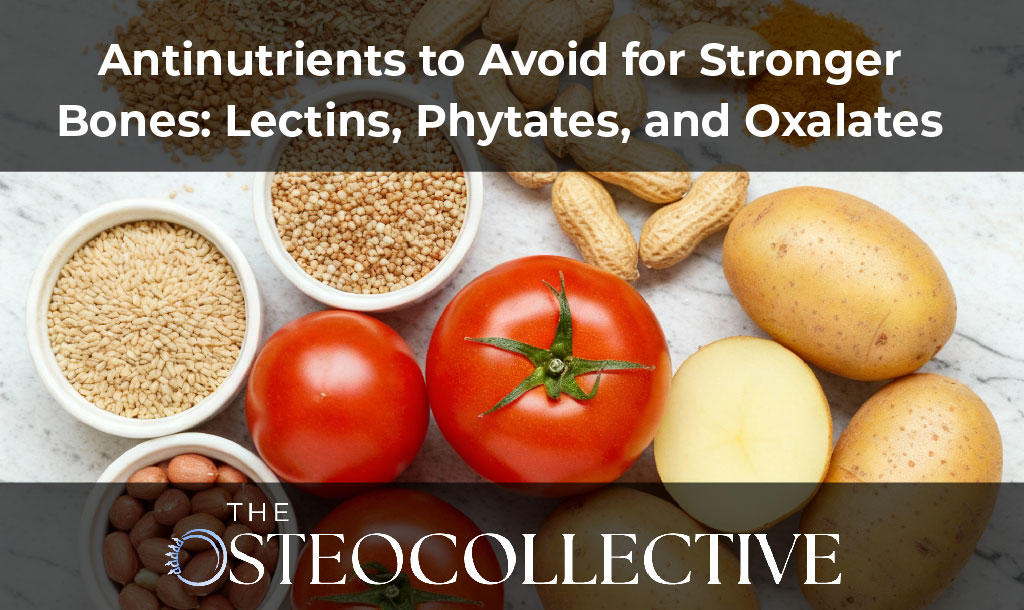live better, longer

Certain natural compounds in plants, called antinutrients, can bind minerals or affect digestion, which may interfere with nutrient absorption if eaten in excess or without proper preparation.
Today, we’ll explore three key groups that can influence bone and mineral metabolism: lectins, phytates, and oxalates.
Lectins are carbohydrate-binding proteins found in many plants, particularly legumes and grains. They serve as part of the plant’s natural defense system and can bind to sugars on cell surfaces in the gut.
When consumed in large amounts or undercooked, lectins may:
Foods containing lectins include:
Cooking and soaking greatly reduce lectins; boiling beans for at least 10 minutes destroys most active lectins. Well-cooked legumes, grains, and vegetables are safe for most people.
“Sometimes you can feel lectin sensitivity, and sometimes you can’t. That’s why I encourage patients to experiment—track what you eat, how it’s prepared, and how you feel afterward.” – Dr. Doug Lucas
Current evidence shows that properly prepared lectin-containing foods are safe for most people and provide valuable nutrients. True lectin intolerance is rare, and elimination should only be considered if symptoms persist.
Phytates, or phytic acid, are storage forms of phosphorus in plants. They can bind minerals like calcium, iron, and zinc, reducing absorption when diets are already low in those minerals.
However, context matters:
Foods rich in phytates:
Because phytates are concentrated in the bran or husk, whole grains naturally contain more, but they also offer more nutrients overall.
Preparation helps:
Phytates don’t need to be eliminated, just managed. When diets include enough minerals and vitamin C, phytate’s impact on bone health is minimal.
Oxalates (oxalic acid) occur naturally in many vegetables and form complexes with calcium that can reduce absorption. In most people, the effect is modest, but high-oxalate diets may contribute to kidney stone risk in those predisposed.
High-oxalate foods:
“I used to put frozen spinach in my smoothies every morning. It seemed healthy, but I noticed I didn’t feel good. Once I cut back, those issues improved.” – Dr. Doug Lucas
Spinach and beet greens are the top contributors to dietary oxalate, but boiling and discarding the water reduces levels by 30–90%.
For most people, oxalates are not dangerous, but those with kidney stone history should limit very high-oxalate foods and pair them with calcium-rich foods (e.g., yogurt, cheese) to bind oxalate safely in the gut.
The goal isn’t to fear plant foods, it’s to prepare them properly and balance your diet.
Modern evidence shows most antinutrients can be neutralized with simple preparation and are only problematic in restrictive, repetitive diets or when nutrient intake is already inadequate.
If your bone density isn’t improving despite “clean eating,” unmanaged antinutrients could play a role, especially if you rely heavily on raw spinach, nuts, or unsoaked legumes.
The fix:
“Our ancestors learned how to soak, sprout, and ferment long before supplements existed. Modern bone health depends on bringing those traditions back.” – Dr. Doug Lucas
👉 If you want to learn how to optimize your nutrition for stronger bones, join me in our free OsteoCollective masterclass. I’ll walk you through the biggest diet mistakes I see (including antinutrients) and show you how to build a sustainable bone health strategy. You’ll also have the chance to ask me your questions live during Q&A.
“Our ancestors learned how to soak, sprout, and ferment long before supplements existed. Modern bone health depends on bringing those traditions back.” – Dr. Doug Lucas
👉 If you want to learn how to optimize your nutrition for stronger bones, join me in our free OsteoCollective masterclass. I’ll walk you through the biggest diet mistakes I see (including antinutrients) and show you how to build a sustainable bone health strategy. You’ll also have the chance to ask me your questions live during Q&A.
Join us LIVE December 22nd, 2025 at 3:00pm EST to Learn Dr. Doug's proven framework for Osteoporosis Reversal for FREE. Yes! Reversing Osteoporosis is possible and has happened for hundreds of Dr. Doug's patients.
If you have been blind-sided, feel stuck, confused, and exhausted with your diagnosis, this Masterclass is for you!
*By providing your phone number, you agree to receive text messages related to webinar reminders, promotional offers, updates, and important announcements from The Osteocollective. Message and data rates may apply. Consent is not a condition of purchase.You may unsubscribe at any time by replying STOP.
We hate spam and promise to keep your email address and phone number safe.
x